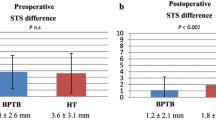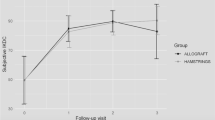Abstract
Purpose
The present study aimed to compare 2- and 5-year outcomes of ACL reconstruction between patients with and without generalized joint laxity and to perform comparative evaluation between two types of grafts used for ACL reconstruction in patients with generalized joint laxity.
Methods
Two hundred and thirty-seven patients who underwent ACL reconstruction from 2001 to 2008 were included. Patients were classified into two groups according to the presence or the absence of generalized joint laxity, and further subdivided into two subgroups based on the type of graft used: bone–patellar tendon–bone (BPTB) or hamstring. Generalized joint laxity was assessed with the Beighton and Horan criteria using a point scoring system. Stability reflected by the Lachman test, pivot-shift test, and anterior translation measured with KT-2000, and functional outcomes reflected by Lysholm knee score, and International Knee Documentation Committee (IKDC) subjective score were investigated. IKDC objective grade and radiographic grade were also assessed. Clinical assessments were conducted preoperatively and at 2 and 5 years after operation.
Results
Two-year follow-up results showed that patients with generalized joint laxity receiving hamstring grafts had poorer outcomes than those without generalized joint laxity. Five-year follow-up results showed that patients with generalized joint laxity experienced poorer outcomes than patients without generalized joint laxity, irrespective of the type of graft. Comparison of grafts used showed that, in patients with generalized joint laxity, BPTB graft provided significantly better stability and functional outcomes than hamstring graft at both 2- and 5-year follow-ups. Comparisons between serial outcomes measured at 2 and 5 years demonstrated that stability and functional outcomes deteriorated over time in patients with generalized joint laxity.
Conclusions
Less satisfactory stability and functional outcomes were noted in patients with generalized joint laxity, compared to patients without generalized joint laxity. Comparisons of stability and functional outcomes after ACL reconstruction in patients with generalized joint laxity between two different grafts demonstrated that BPTB graft achieves better results than hamstring graft.
Level of evidence
III, a retrospective cohort study.
Similar content being viewed by others
References
Beighton P, Horan F (1969) Orthopaedic aspects of the Ehlers-Danlos syndrome. J Bone Joint Surg Br 51(3):444–453
Briggs KK, Lysholm J, Tegner Y, Rodkey WG, Kocher MS, Steadman JR (2009) The reliability, validity, and responsiveness of the Lysholm score and Tegner activity scale for anterior cruciate ligament injuries of the knee: 25 years later. Am J Sports Med 37(5):890–897
Crawford SN, Waterman BR, Lubowitz JH (2013) Long-term failure of anterior cruciate ligament reconstruction. Arthroscopy 29(9):1566–1571
DePhillipo NN, Cinque ME, Chahla J, Geeslin AG, LaPrade RF (2017) Anterolateral ligament reconstruction techniques, biomechanics, and clinical outcomes: a systematic review. Arthroscopy 33(8):1575–1583
Dodds AL, Halewood C, Gupte CM, Williams A, Amis AA (2014) The anterolateral ligament. Anatomy, length changes and association with the Segond fracture. Bone Joint J 96-B(3):325–331
Faul F, Erdfelder E, Buchner A, Lang AG (2009) Statistical power analyses using G*Power 3.1: tests for correlation and regression analyses. Behav Res Methods 41(4):1149–1160
Gobbi A, Domzalski M, Pascual J (2004) Comparison of anterior cruciate ligament reconstruction in male and female athletes using the patellar tendon and hamstring autografts. Knee Surg Sports Traumatol Arthrosc 12(6):534–539
Grassi A, Nitri M, Moulton SG, Marcheggiani Muccioli GM, Bondi A, Romagnoli M, Zaffagnini S (2017) Does the type of graft affect the outcome of revision anterior cruciate ligament reconstruction? a meta-analysis of 32 studies. Bone Joint J 99-b(6):714–723
Greco NJ, Anderson AF, Mann BJ, Cole BJ, Farr J, Nissen CW, Irrgang JJ (2010) Responsiveness of the International Knee Documentation Committee Subjective Knee Form in comparison to the Western Ontario and McMaster Universities Osteoarthritis Index, modified Cincinnati Knee Rating System, and Short Form 36 in patients with focal articular cartilage defects. Am J Sports Med 38(5):891–902
Hardin JA, Voight ML, Blackburn TA, Canner GC, Soffer SR (1997) The effects of “decelerated” rehabilitation following anterior cruciate ligament reconstruction on a hyperelastic female adolescent: a case study. J Orthop Sports Phys Ther 26(1):29–34
Hefti F, Muller W, Jakob RP, Staubli HU (1993) Evaluation of knee ligament injuries with the IKDC form. Knee Surg Sports Traumatol Arthrosc 1(3–4):226–234
Jagodzinski M, Leis A, Iselborn KW, Mall G, Nerlich M, Bosch U (2003) Impingement pressure and tension forces of the anterior cruciate ligament. Knee Surg Sports Traumatol Arthrosc 11(2):85–90
Janssen RPA, Scheffler SU (2014) Intra-articular remodelling of hamstring tendon grafts after anterior cruciate ligament reconstruction. Knee Surg Sports Traumatol Arthrosc 22(9):2102–2108
Kamath GV, Redfern JC, Greis PE, Burks RT (2011) Revision anterior cruciate ligament reconstruction. Am J Sports Med 39(1):199–217
Kim SJ, Choi DH, Mei Y, Hwang BY (2011) Does physiologic posterolateral laxity influence clinical outcomes of anterior cruciate ligament reconstruction? J Bone Joint Surg Am 93(21):2010–2014
Kim SJ, Kim TE, Lee DH, Oh KS (2008) Anterior cruciate ligament reconstruction in patients who have excessive joint laxity. J Bone Joint Surg Am 90(4):735–741
Kim SJ, Kumar P, Oh KS (2009) Anterior cruciate ligament reconstruction: autogenous quadriceps tendon-bone compared with bone-patellar tendon-bone grafts at 2-year follow-up. Arthroscopy 25(2):137–144
Kim SJ, Lee SK, Kim SH, Kim SH, Kim JS, Jung M (2014) Does anterior laxity of the uninjured knee influence clinical outcomes of ACL reconstruction? J Bone Joint Surg Am 96(7):543–548
Kim SJ, Moon HK, Kim SG, Chun YM, Oh KS (2010) Does severity or specific joint laxity influence clinical outcomes of anterior cruciate ligament reconstruction? Clin Orthop Relat Res 468(4):1136–1141
Kumar B, Lenert P (2017) Joint Hypermobility Syndrome: Recognizing a Commonly Overlooked Cause of Chronic Pain. Am J Med 130(6):640–647
Lysholm J, Gillquist J (1982) Evaluation of knee ligament surgery results with special emphasis on use of a scoring scale. Am J Sports Med 10(3):150–154
Myer GD, Ford KR, Paterno MV, Nick TG, Hewett TE (2008) The effects of generalized joint laxity on risk of anterior cruciate ligament injury in young female athletes. Am J Sports Med 36(6):1073–1080
Noojin FK, Barrett GR, Hartzog CW, Nash CR (2000) Clinical comparison of intraarticular anterior cruciate ligament reconstruction using autogenous semitendinosus and gracilis tendons in men versus women. Am J Sports Med 28(6):783–789
Outerbridge RE (1961) The etiology of chondromalacia patellae. J Bone Joint Surg Br 43-b:752–757
Pagnani MJ, Warner JJ, O’Brien SJ, Warren RF (1993) Anatomic considerations in harvesting the semitendinosus and gracilis tendons and a technique of harvest. Am J Sports Med 21(4):565–571
Park HS, Wilson NA, Zhang LQ (2008) Gender differences in passive knee biomechanical properties in tibial rotation. J Orthop Res 26(7):937–944
Pinczewski LA, Lyman J, Salmon LJ, Russell VJ, Roe J, Linklater J (2007) A 10-year comparison of anterior cruciate ligament reconstructions with hamstring tendon and patellar tendon autograft: a controlled, prospective trial. Am J Sports Med 35(4):564–574
Rodney WB, Shelbourne KD, Tinker G (2016) The degree of knee extension does not affect postoperative stability or subsequent graft tear rate after anterior cruciate ligament reconstruction with patellar tendon autograft. Am J Sports Med 44(4):844–849
Roe J, Pinczewski LA, Russell VJ, Salmon LJ, Kawamata T, Chew M (2005) A 7-year follow-up of patellar tendon and hamstring tendon grafts for arthroscopic anterior cruciate ligament reconstruction: differences and similarities. Am J Sports Med 33(9):1337–1345
Spragg L, Chen J, Mirzayan R, Love R, Maletis G (2016) The effect of autologous hamstring graft diameter on the likelihood for revision of anterior cruciate ligament reconstruction. Am J Sports Med 44(6):1475–1481
Ted S, Gen E, Tomoki Y (2016) Generalized joint laxity and ligament injuries in high school–aged female volleyball players in Japan. Orthop J Sports Med 4(10):2325967116667690
Vincent J-P, Magnussen RA, Gezmez F, Uguen A, Jacobi M, Weppe F, Al-Saati MaF, Lustig S, Demey G, Servien E, Neyret P (2012) The anterolateral ligament of the human knee: an anatomic and histologic study. Knee Surg Sports Traumatol Arthrosc 20(1):147–152
Xie X, Liu X, Chen Z, Yu Y, Peng S, Li Q (2015) A meta-analysis of bone-patellar tendon-bone autograft versus four-strand hamstring tendon autograft for anterior cruciate ligament reconstruction. Knee 22(2):100–110
Funding
There is no funding source.
Author information
Authors and Affiliations
Corresponding author
Ethics declarations
Conflict of interest
The authors declare that they have no conflict of interest.
Ethical approval
This study was conducted following the approval of Institutional Review Board of Severance Hospital, Yonsei University College of Medicine (IRB number 4-2017-0303).
Informed consent
This retrospective study received exemption from informed consent by the Institutional Review Board of Severance Hospital.
Appendix
Appendix
See Tables 6, 7, 8, 9, 10, 11, 12, 13 and 14.
Rights and permissions
About this article
Cite this article
Kim, SJ., Choi, C.H., Kim, SH. et al. Bone–patellar tendon–bone autograft could be recommended as a superior graft to hamstring autograft for ACL reconstruction in patients with generalized joint laxity: 2- and 5-year follow-up study. Knee Surg Sports Traumatol Arthrosc 26, 2568–2579 (2018). https://doi.org/10.1007/s00167-018-4881-y
Received:
Accepted:
Published:
Issue Date:
DOI: https://doi.org/10.1007/s00167-018-4881-y




